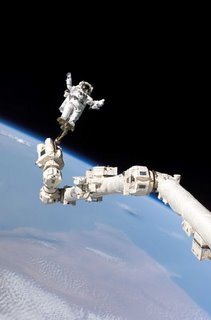
One of the areas where robots have a very important role is in the building of the International Space Station (ISS). ISS is a research facility being built in orbit under collaboration of NASA, Canadian Space Agency (CSA), European Space Agency (ESA), Russian Federal Space Agency and Japan Aerospace Exploration Agency (JAXA).The assembly of modules and maintenance of the station require Extra-Vehicular Activities (EVA) performed by the astronauts. These are usually expensive and dangerous. This is where the robot manipulator comes in to rescue. The robot manipulator can help perform most of the common repairs and operations without the astronaut ever setting foot outside the ISS.
At present ISS is equipped with Mobile Servicing System or Canada Arm 2.It was built by MD Robotics in
One of the amazing features of the manipulator is its Mobile Base System (MBS). Unlike most of the manipulator systems that have a fixed base, MBS allows the manipulator to move around on the external truss of ISS. MBS acts as a platform for storing payloads while astronauts work and has 4 grapple points for the robotic arms to attach. The manipulator has Latch End Effectors (LEE) on both ends that help it attach it to the Power Data Grapple Fixtures (PDFGs). PDFG supply power and data to the robot arm and are spread around on the surface of the work station. The manipulator arm can relocate itself in an inchworm fashion by going from one PDFG to another using both its ends or it can use the MBS.
The sensors on the manipulator include 4 colour cameras to supply video data to the astronauts and force moment sensors which give it a sense of touch. The manipulator arm can also automatically detect collisions about to happen and avoid them. The control of the manipulator can be done by the astronaut or it can work autonomously for minor tasks.
More manipulators are expected to be added to the ISS. The future robot arms will help build large work stations and will make full use of the gravity less environment for energy efficiency e.g. SkyWorker. With help intelligent and efficient tools space colonisation will be much safer and faster.
CSA- Canada Arm 2
http://www.space.gc.ca/asc/app/gallery/results2.asp?image_id=module_mini
NASA- Comparison of robotic Arms
http://www.nasa.gov/mission_pages/station/structure/elements/mss.html
European Robotic Arm
http://www.esa.int/esaHS/ESAQEI0VMOC_iss_0.html
http://www.ksc.nasa.gov/nasadirect/archives/KSCDirect/archives/launch/sts111/carm-qa.htm
SkyWorker
http://www.frc.ri.cmu.edu/projects/skyworker/
1 comment:
serious topic you raised. it could be a really breakthrough in space tech! so interesting
custom research writing service
Post a Comment